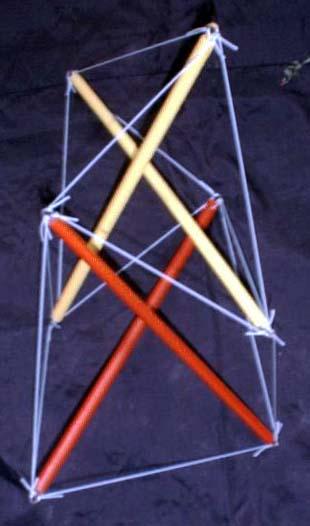

In contrast to the Infinite-Stage X-Module Column, this design concentrates completely on end effects and is eminently buildable (see the datasheet). This is exactly the structure that Kenneth Snelson exhibits in his essay on X-Modules. It certainly deserves a place in the pantheon of fundamental tensegrity structures.
For a short time I referred to these structures as "chains" rather than "columns" as Snelson does. I thought "chain" suggested more orientations than "column" did. On second thought though, I saw "column" suggests a compression component, which is what these structures amount to, while "chain" suggests a tensile component. This seems to me a major mislabeling compared to what I was quibbling with in Snelson's term, so I'll stick with his term. "beam" seems like another possibility.
I note that Snelson doesn't refer to these structures as "towers", a term which he uses to refer to three- and four-fold versions of these structures. I suspect this is due to the fact that these two-fold structures can't stand up on their own like the three- and four-fold ones can. I'd be tempted to call them "masts", but this is a Bucky term which Snelson doesn't care to see decorating structures based on his inventions.
Snelson developed the X-Module in late 1959 upon returning to the tensegrity scene after an absence of ten years to work on documentaries in New York City and study painting. In his International Journal of Space Structures article of 1996, "Snelson on the Tensegrity Invention" (Vol. 11, Nos. 1 & 2, p. 47), Snelson states:
The rich irony not to be overlooked in this teacher-student story, is that because of Bucky's hasty and desperate decision early on to swap the tetrahedral module for my Xs, and its subsequent disappearance caused the original form to be buried completely. In the ten intervening years that Bucky's tetrahedral modification was seen and published everywhere, no one, student or disciple, reinvented the X-module. Fate or destiny or good luck safe-deposited it, waiting for my time to reclaim it.
In 1960 I applied for a patent for the principle of the X-Module and its capability to expand in all directions. Though a decade old, the structure had never been published. (Figure 5 Illustrations from US Patent 3,169,611 entitled `Continuous Tension, Discontinuous Compression Structures', dated February 16, 1965, filed March 14, 1960.)
What followed, was the many years of my experimenting and learning about the X module's remarkable properties -- and making hundreds of sculptures, many of them sited in major museums, cities and collections worldwide.
The X-module still seems to suffer from neglect by everyone except Snelson. His needle tower technology (see Tensegrity Tower which also has a link to a page illustrating some of Snelson's X-module "walking" sculptures) seems to get much more attention though I think the X-module is at least as worthy. Another significant area of his research were his planar structures though this work doesn't seem to have found a way into his art.
I completed building the two-stage column on March 23, 2004. I was surprised to find I got as much clearance between the struts as I did (center-to-center clearance per unit strut length = 0.134). 1959 (actually December, 1958) is also remarkable as the year that David Emmerich started building tensegrity structures.


